Formation of Contractual Relationships: Analysis of Legal Principles
VerifiedAdded on 2023/01/06
|8
|2152
|75
Report
AI Summary
This report provides a detailed analysis of contract law, focusing on the formation of contractual relationships. It defines contract law, outlines the essential blueprints of a contract, and explores the English court system. The report advises on the existence of binding contracts between parties (Eleanor, Amy, and Olivia) based on the provided scenarios, considering offers, counteroffers, and acceptance rules. It examines the remedies available for breach of contract, including damages, specific performance, and injunctions. The report concludes by summarizing the key differences between offers and invitations to treat and emphasizes the importance of the court system in resolving contractual disputes. The report is contributed to Desklib, a platform for students to access AI-based study tools and resources, including past papers and solved assignments.

FORMATION OF
CONTRACTUAL
RELATIONSHIPS
CONTRACTUAL
RELATIONSHIPS
Paraphrase This Document
Need a fresh take? Get an instant paraphrase of this document with our AI Paraphraser
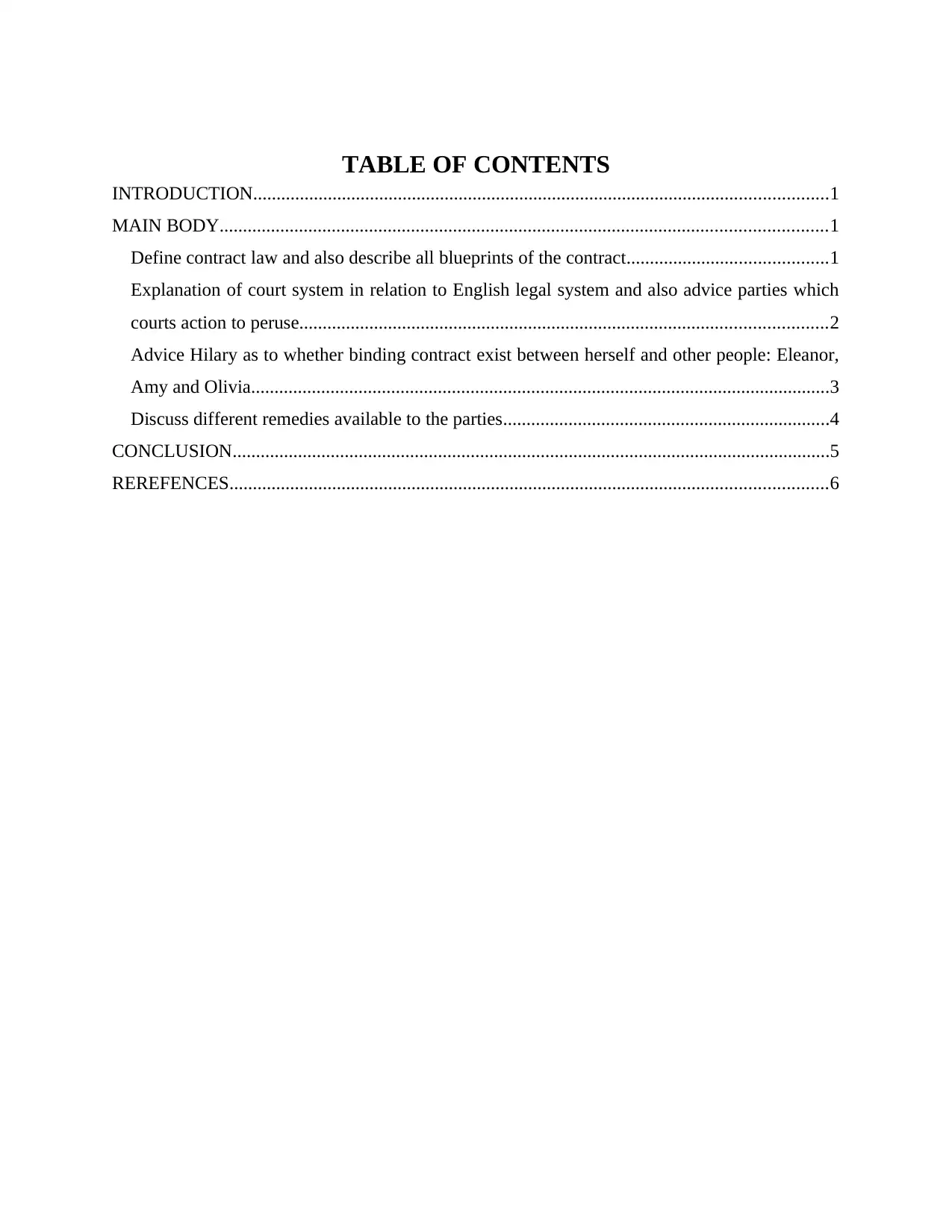
TABLE OF CONTENTS
INTRODUCTION...........................................................................................................................1
MAIN BODY..................................................................................................................................1
Define contract law and also describe all blueprints of the contract...........................................1
Explanation of court system in relation to English legal system and also advice parties which
courts action to peruse.................................................................................................................2
Advice Hilary as to whether binding contract exist between herself and other people: Eleanor,
Amy and Olivia............................................................................................................................3
Discuss different remedies available to the parties......................................................................4
CONCLUSION................................................................................................................................5
REREFENCES................................................................................................................................6
INTRODUCTION...........................................................................................................................1
MAIN BODY..................................................................................................................................1
Define contract law and also describe all blueprints of the contract...........................................1
Explanation of court system in relation to English legal system and also advice parties which
courts action to peruse.................................................................................................................2
Advice Hilary as to whether binding contract exist between herself and other people: Eleanor,
Amy and Olivia............................................................................................................................3
Discuss different remedies available to the parties......................................................................4
CONCLUSION................................................................................................................................5
REREFENCES................................................................................................................................6
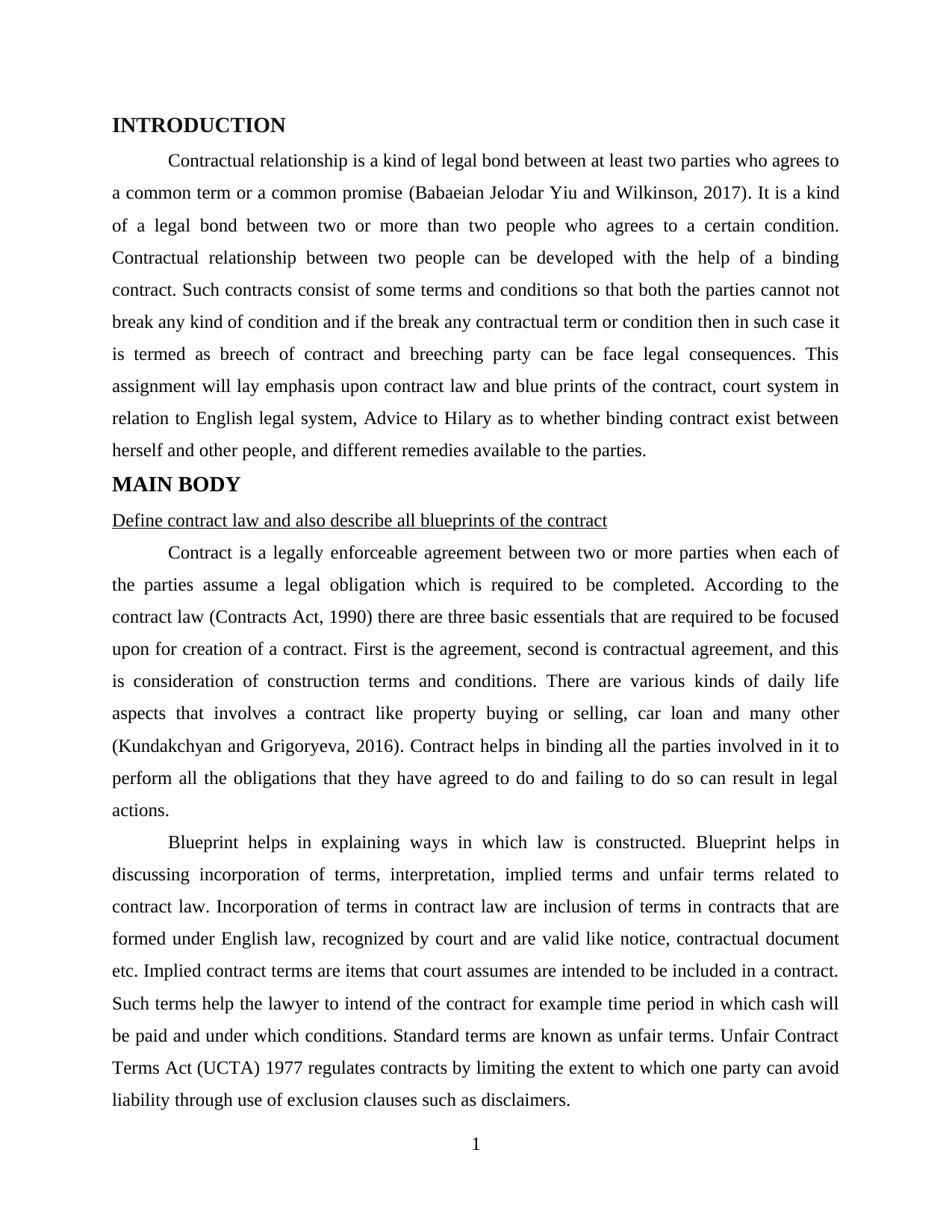
INTRODUCTION
Contractual relationship is a kind of legal bond between at least two parties who agrees to
a common term or a common promise (Babaeian Jelodar Yiu and Wilkinson, 2017). It is a kind
of a legal bond between two or more than two people who agrees to a certain condition.
Contractual relationship between two people can be developed with the help of a binding
contract. Such contracts consist of some terms and conditions so that both the parties cannot not
break any kind of condition and if the break any contractual term or condition then in such case it
is termed as breech of contract and breeching party can be face legal consequences. This
assignment will lay emphasis upon contract law and blue prints of the contract, court system in
relation to English legal system, Advice to Hilary as to whether binding contract exist between
herself and other people, and different remedies available to the parties.
MAIN BODY
Define contract law and also describe all blueprints of the contract
Contract is a legally enforceable agreement between two or more parties when each of
the parties assume a legal obligation which is required to be completed. According to the
contract law (Contracts Act, 1990) there are three basic essentials that are required to be focused
upon for creation of a contract. First is the agreement, second is contractual agreement, and this
is consideration of construction terms and conditions. There are various kinds of daily life
aspects that involves a contract like property buying or selling, car loan and many other
(Kundakchyan and Grigoryeva, 2016). Contract helps in binding all the parties involved in it to
perform all the obligations that they have agreed to do and failing to do so can result in legal
actions.
Blueprint helps in explaining ways in which law is constructed. Blueprint helps in
discussing incorporation of terms, interpretation, implied terms and unfair terms related to
contract law. Incorporation of terms in contract law are inclusion of terms in contracts that are
formed under English law, recognized by court and are valid like notice, contractual document
etc. Implied contract terms are items that court assumes are intended to be included in a contract.
Such terms help the lawyer to intend of the contract for example time period in which cash will
be paid and under which conditions. Standard terms are known as unfair terms. Unfair Contract
Terms Act (UCTA) 1977 regulates contracts by limiting the extent to which one party can avoid
liability through use of exclusion clauses such as disclaimers.
1
Contractual relationship is a kind of legal bond between at least two parties who agrees to
a common term or a common promise (Babaeian Jelodar Yiu and Wilkinson, 2017). It is a kind
of a legal bond between two or more than two people who agrees to a certain condition.
Contractual relationship between two people can be developed with the help of a binding
contract. Such contracts consist of some terms and conditions so that both the parties cannot not
break any kind of condition and if the break any contractual term or condition then in such case it
is termed as breech of contract and breeching party can be face legal consequences. This
assignment will lay emphasis upon contract law and blue prints of the contract, court system in
relation to English legal system, Advice to Hilary as to whether binding contract exist between
herself and other people, and different remedies available to the parties.
MAIN BODY
Define contract law and also describe all blueprints of the contract
Contract is a legally enforceable agreement between two or more parties when each of
the parties assume a legal obligation which is required to be completed. According to the
contract law (Contracts Act, 1990) there are three basic essentials that are required to be focused
upon for creation of a contract. First is the agreement, second is contractual agreement, and this
is consideration of construction terms and conditions. There are various kinds of daily life
aspects that involves a contract like property buying or selling, car loan and many other
(Kundakchyan and Grigoryeva, 2016). Contract helps in binding all the parties involved in it to
perform all the obligations that they have agreed to do and failing to do so can result in legal
actions.
Blueprint helps in explaining ways in which law is constructed. Blueprint helps in
discussing incorporation of terms, interpretation, implied terms and unfair terms related to
contract law. Incorporation of terms in contract law are inclusion of terms in contracts that are
formed under English law, recognized by court and are valid like notice, contractual document
etc. Implied contract terms are items that court assumes are intended to be included in a contract.
Such terms help the lawyer to intend of the contract for example time period in which cash will
be paid and under which conditions. Standard terms are known as unfair terms. Unfair Contract
Terms Act (UCTA) 1977 regulates contracts by limiting the extent to which one party can avoid
liability through use of exclusion clauses such as disclaimers.
1
⊘ This is a preview!⊘
Do you want full access?
Subscribe today to unlock all pages.

Trusted by 1+ million students worldwide

Explanation of court system in relation to English legal system and also advice parties which
courts action to peruse
Below structure can help in explaining court system in relation to English legal system.
Figure 1 Structure of courts
(Source: Structure of the Courts. 2020)
There are different kinds of cases dealt with in different kinds of courts. Like for criminal
cases, cases can be applied in magistrate’s court. But when more serious criminal matters come
into picture then in such, cases go to Crown court. If case is not resolved at this level, them
appeal goes to High court and then to supreme court (Beale and et. al., 2019). Civil cases are
mostly dealt magistrates but can go up to country court. Appeal can also go to high court and
then court of appeal.
Parties can appeal at magistrate level and should focus upon resolving the case at this
level and if the case is not resolved then they can appeal to country court and if still the case is
not resolved then they can appeal to high court. Hilary can appeal at magistrate level for
resolving her care with Amy. If it is not resolved, then she can appeal to county court and then
high court.
2
courts action to peruse
Below structure can help in explaining court system in relation to English legal system.
Figure 1 Structure of courts
(Source: Structure of the Courts. 2020)
There are different kinds of cases dealt with in different kinds of courts. Like for criminal
cases, cases can be applied in magistrate’s court. But when more serious criminal matters come
into picture then in such, cases go to Crown court. If case is not resolved at this level, them
appeal goes to High court and then to supreme court (Beale and et. al., 2019). Civil cases are
mostly dealt magistrates but can go up to country court. Appeal can also go to high court and
then court of appeal.
Parties can appeal at magistrate level and should focus upon resolving the case at this
level and if the case is not resolved then they can appeal to country court and if still the case is
not resolved then they can appeal to high court. Hilary can appeal at magistrate level for
resolving her care with Amy. If it is not resolved, then she can appeal to county court and then
high court.
2
Paraphrase This Document
Need a fresh take? Get an instant paraphrase of this document with our AI Paraphraser
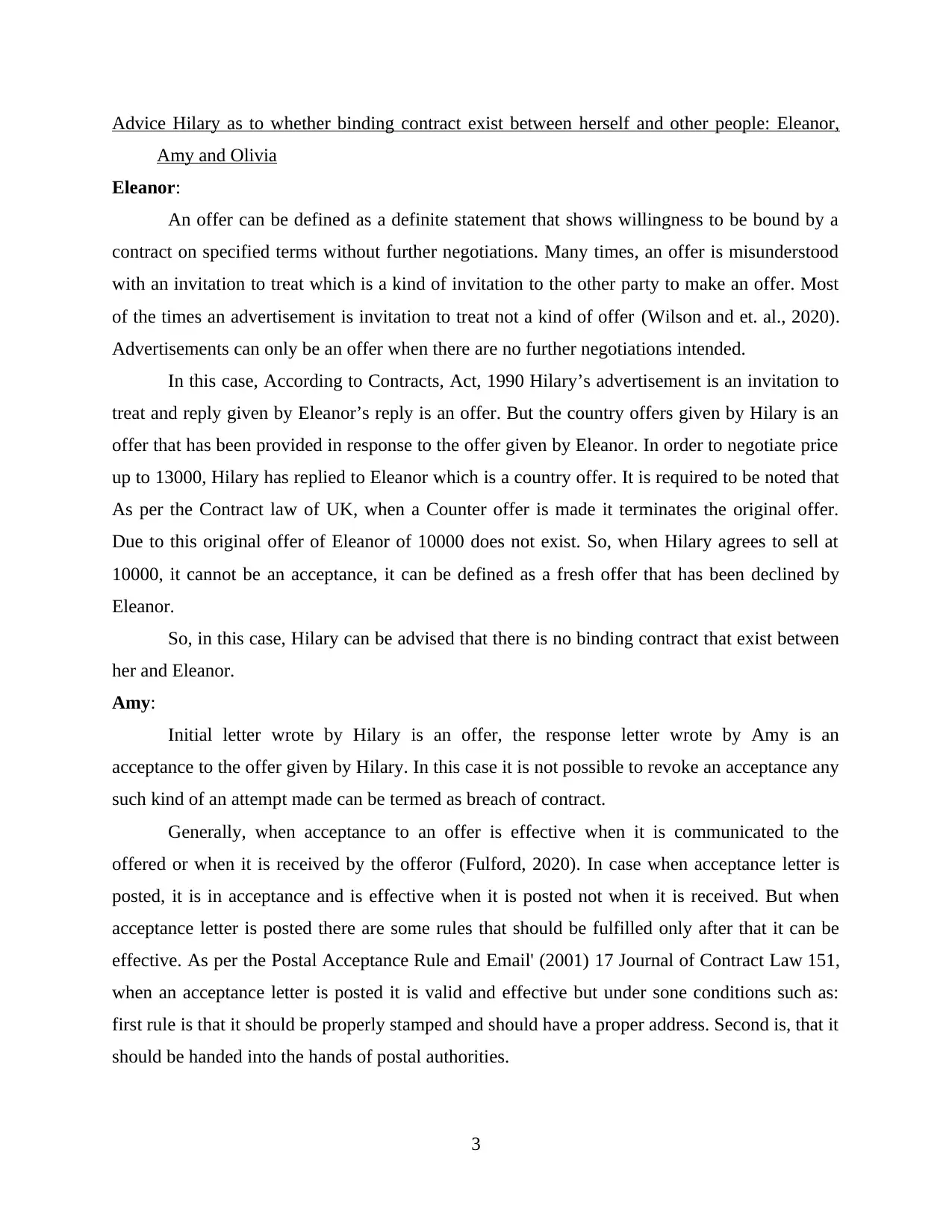
Advice Hilary as to whether binding contract exist between herself and other people: Eleanor,
Amy and Olivia
Eleanor:
An offer can be defined as a definite statement that shows willingness to be bound by a
contract on specified terms without further negotiations. Many times, an offer is misunderstood
with an invitation to treat which is a kind of invitation to the other party to make an offer. Most
of the times an advertisement is invitation to treat not a kind of offer (Wilson and et. al., 2020).
Advertisements can only be an offer when there are no further negotiations intended.
In this case, According to Contracts, Act, 1990 Hilary’s advertisement is an invitation to
treat and reply given by Eleanor’s reply is an offer. But the country offers given by Hilary is an
offer that has been provided in response to the offer given by Eleanor. In order to negotiate price
up to 13000, Hilary has replied to Eleanor which is a country offer. It is required to be noted that
As per the Contract law of UK, when a Counter offer is made it terminates the original offer.
Due to this original offer of Eleanor of 10000 does not exist. So, when Hilary agrees to sell at
10000, it cannot be an acceptance, it can be defined as a fresh offer that has been declined by
Eleanor.
So, in this case, Hilary can be advised that there is no binding contract that exist between
her and Eleanor.
Amy:
Initial letter wrote by Hilary is an offer, the response letter wrote by Amy is an
acceptance to the offer given by Hilary. In this case it is not possible to revoke an acceptance any
such kind of an attempt made can be termed as breach of contract.
Generally, when acceptance to an offer is effective when it is communicated to the
offered or when it is received by the offeror (Fulford, 2020). In case when acceptance letter is
posted, it is in acceptance and is effective when it is posted not when it is received. But when
acceptance letter is posted there are some rules that should be fulfilled only after that it can be
effective. As per the Postal Acceptance Rule and Email' (2001) 17 Journal of Contract Law 151,
when an acceptance letter is posted it is valid and effective but under sone conditions such as:
first rule is that it should be properly stamped and should have a proper address. Second is, that it
should be handed into the hands of postal authorities.
3
Amy and Olivia
Eleanor:
An offer can be defined as a definite statement that shows willingness to be bound by a
contract on specified terms without further negotiations. Many times, an offer is misunderstood
with an invitation to treat which is a kind of invitation to the other party to make an offer. Most
of the times an advertisement is invitation to treat not a kind of offer (Wilson and et. al., 2020).
Advertisements can only be an offer when there are no further negotiations intended.
In this case, According to Contracts, Act, 1990 Hilary’s advertisement is an invitation to
treat and reply given by Eleanor’s reply is an offer. But the country offers given by Hilary is an
offer that has been provided in response to the offer given by Eleanor. In order to negotiate price
up to 13000, Hilary has replied to Eleanor which is a country offer. It is required to be noted that
As per the Contract law of UK, when a Counter offer is made it terminates the original offer.
Due to this original offer of Eleanor of 10000 does not exist. So, when Hilary agrees to sell at
10000, it cannot be an acceptance, it can be defined as a fresh offer that has been declined by
Eleanor.
So, in this case, Hilary can be advised that there is no binding contract that exist between
her and Eleanor.
Amy:
Initial letter wrote by Hilary is an offer, the response letter wrote by Amy is an
acceptance to the offer given by Hilary. In this case it is not possible to revoke an acceptance any
such kind of an attempt made can be termed as breach of contract.
Generally, when acceptance to an offer is effective when it is communicated to the
offered or when it is received by the offeror (Fulford, 2020). In case when acceptance letter is
posted, it is in acceptance and is effective when it is posted not when it is received. But when
acceptance letter is posted there are some rules that should be fulfilled only after that it can be
effective. As per the Postal Acceptance Rule and Email' (2001) 17 Journal of Contract Law 151,
when an acceptance letter is posted it is valid and effective but under sone conditions such as:
first rule is that it should be properly stamped and should have a proper address. Second is, that it
should be handed into the hands of postal authorities.
3

If both of these rules are applied then in this case, the letter is effective when it is posted.
If both the rules are seen, then: it can be assumed that the letter was properly stamped and had a
proper address. As Hilary offered by post then it can be assumed that Amy also replied by post.
So, it is advised to Hilary under Postal Acceptance Rule and Email' (2001) 17 Journal
of Contract Law 151 that a binding contract does exist between Amy and Hilary When the time
Amy posted the acceptance letter, later fax done by Amy cannot revoke her acceptance letter it
will be considered as a breech of contract.
Olivia:
In this case also, advertisement given by Hilary is an invitation to treat not an offer. It was
a declaration of commencement of sale of painting. So, it is advised UNer Contracts Act, 1990 to
Hilary, that Her and Olivia do not hold any kind of binding contract. The advertisement given by
her was an invitation to treat not a kind of solid and binding contract between both the parties.
Conclusion:
From the above discussion it is clear that Hilary holds only one contract with Amy. She
does not only any kind of contract with Eleanor and Hilary.
Discuss different remedies available to the parties
There are three kinds of remedies available to the parties:
Damages: each and every kind of failure to perform primary obligation is a breach of
contract (Evans, 2018). Secondary obligation is when a part of contract breaks it gives rise to
consequences of breach. In such case penalty is set for the breaker and they need to pay the
penalty as a compensation. This remedy is available for Amy as she is the one who has
broken the contract so either she can buy the computer or else she can pay the penalty in
order to come out of the contract.
Specific performance: Any kind of specific performance requires breeching party to
complete their part in the contract. It is only applicable when remedy of damage is not
applicable. In this the other party applies in court to force other breeching party to perform
terms and condition in the contract. If this remedy is applicable, then court can force the
breeching party to perform all the task that are stated in the contract. But this remedy is
mostly not used by parties as in this both the parties can face a hard time as well as it is a
time- consuming remedy. This remedy can be used by Hilary in case of Amy as she is the
4
If both the rules are seen, then: it can be assumed that the letter was properly stamped and had a
proper address. As Hilary offered by post then it can be assumed that Amy also replied by post.
So, it is advised to Hilary under Postal Acceptance Rule and Email' (2001) 17 Journal
of Contract Law 151 that a binding contract does exist between Amy and Hilary When the time
Amy posted the acceptance letter, later fax done by Amy cannot revoke her acceptance letter it
will be considered as a breech of contract.
Olivia:
In this case also, advertisement given by Hilary is an invitation to treat not an offer. It was
a declaration of commencement of sale of painting. So, it is advised UNer Contracts Act, 1990 to
Hilary, that Her and Olivia do not hold any kind of binding contract. The advertisement given by
her was an invitation to treat not a kind of solid and binding contract between both the parties.
Conclusion:
From the above discussion it is clear that Hilary holds only one contract with Amy. She
does not only any kind of contract with Eleanor and Hilary.
Discuss different remedies available to the parties
There are three kinds of remedies available to the parties:
Damages: each and every kind of failure to perform primary obligation is a breach of
contract (Evans, 2018). Secondary obligation is when a part of contract breaks it gives rise to
consequences of breach. In such case penalty is set for the breaker and they need to pay the
penalty as a compensation. This remedy is available for Amy as she is the one who has
broken the contract so either she can buy the computer or else she can pay the penalty in
order to come out of the contract.
Specific performance: Any kind of specific performance requires breeching party to
complete their part in the contract. It is only applicable when remedy of damage is not
applicable. In this the other party applies in court to force other breeching party to perform
terms and condition in the contract. If this remedy is applicable, then court can force the
breeching party to perform all the task that are stated in the contract. But this remedy is
mostly not used by parties as in this both the parties can face a hard time as well as it is a
time- consuming remedy. This remedy can be used by Hilary in case of Amy as she is the
4
⊘ This is a preview!⊘
Do you want full access?
Subscribe today to unlock all pages.

Trusted by 1+ million students worldwide
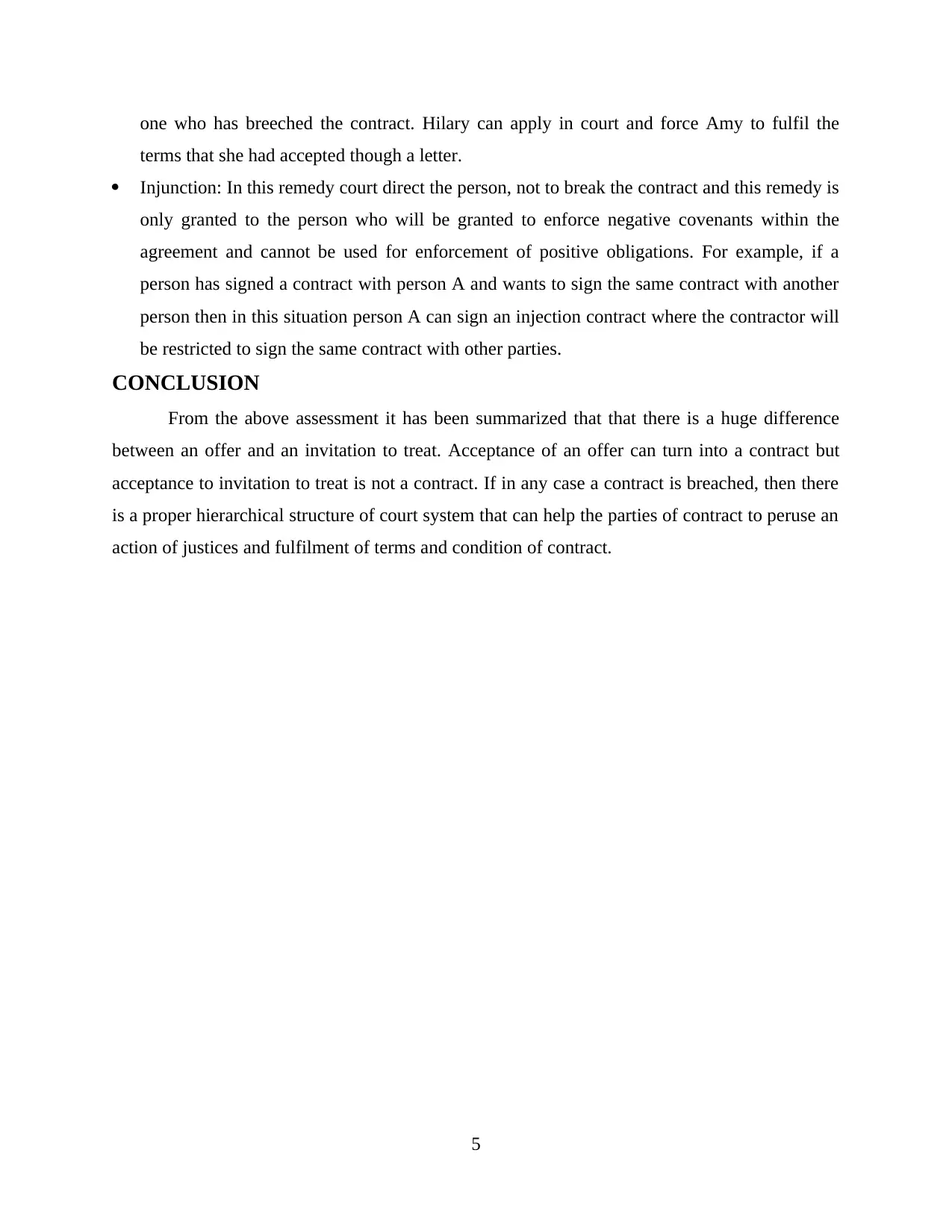
one who has breeched the contract. Hilary can apply in court and force Amy to fulfil the
terms that she had accepted though a letter.
Injunction: In this remedy court direct the person, not to break the contract and this remedy is
only granted to the person who will be granted to enforce negative covenants within the
agreement and cannot be used for enforcement of positive obligations. For example, if a
person has signed a contract with person A and wants to sign the same contract with another
person then in this situation person A can sign an injection contract where the contractor will
be restricted to sign the same contract with other parties.
CONCLUSION
From the above assessment it has been summarized that that there is a huge difference
between an offer and an invitation to treat. Acceptance of an offer can turn into a contract but
acceptance to invitation to treat is not a contract. If in any case a contract is breached, then there
is a proper hierarchical structure of court system that can help the parties of contract to peruse an
action of justices and fulfilment of terms and condition of contract.
5
terms that she had accepted though a letter.
Injunction: In this remedy court direct the person, not to break the contract and this remedy is
only granted to the person who will be granted to enforce negative covenants within the
agreement and cannot be used for enforcement of positive obligations. For example, if a
person has signed a contract with person A and wants to sign the same contract with another
person then in this situation person A can sign an injection contract where the contractor will
be restricted to sign the same contract with other parties.
CONCLUSION
From the above assessment it has been summarized that that there is a huge difference
between an offer and an invitation to treat. Acceptance of an offer can turn into a contract but
acceptance to invitation to treat is not a contract. If in any case a contract is breached, then there
is a proper hierarchical structure of court system that can help the parties of contract to peruse an
action of justices and fulfilment of terms and condition of contract.
5
Paraphrase This Document
Need a fresh take? Get an instant paraphrase of this document with our AI Paraphraser
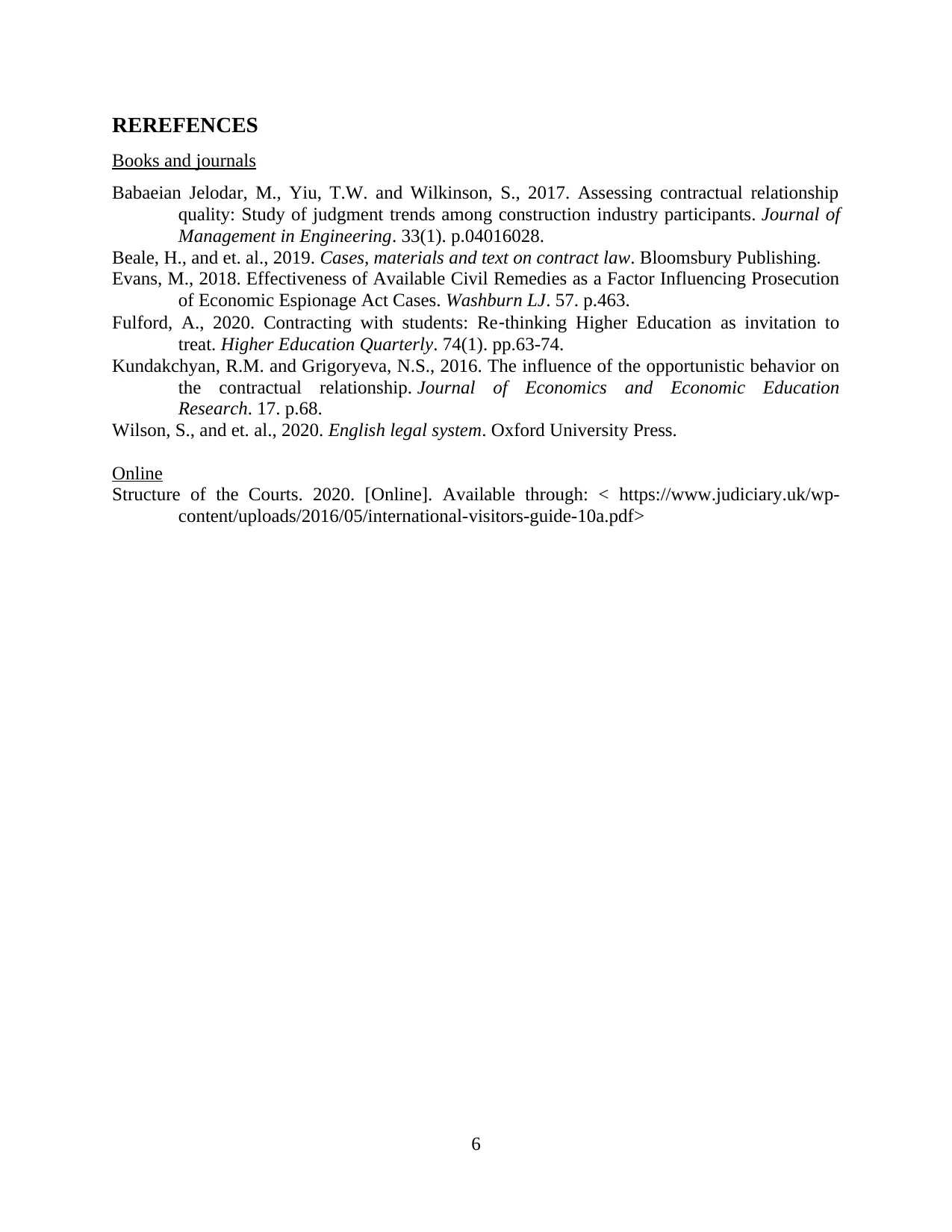
REREFENCES
Books and journals
Babaeian Jelodar, M., Yiu, T.W. and Wilkinson, S., 2017. Assessing contractual relationship
quality: Study of judgment trends among construction industry participants. Journal of
Management in Engineering. 33(1). p.04016028.
Beale, H., and et. al., 2019. Cases, materials and text on contract law. Bloomsbury Publishing.
Evans, M., 2018. Effectiveness of Available Civil Remedies as a Factor Influencing Prosecution
of Economic Espionage Act Cases. Washburn LJ. 57. p.463.
Fulford, A., 2020. Contracting with students: Re‐thinking Higher Education as invitation to
treat. Higher Education Quarterly. 74(1). pp.63-74.
Kundakchyan, R.M. and Grigoryeva, N.S., 2016. The influence of the opportunistic behavior on
the contractual relationship. Journal of Economics and Economic Education
Research. 17. p.68.
Wilson, S., and et. al., 2020. English legal system. Oxford University Press.
Online
Structure of the Courts. 2020. [Online]. Available through: < https://www.judiciary.uk/wp-
content/uploads/2016/05/international-visitors-guide-10a.pdf>
6
Books and journals
Babaeian Jelodar, M., Yiu, T.W. and Wilkinson, S., 2017. Assessing contractual relationship
quality: Study of judgment trends among construction industry participants. Journal of
Management in Engineering. 33(1). p.04016028.
Beale, H., and et. al., 2019. Cases, materials and text on contract law. Bloomsbury Publishing.
Evans, M., 2018. Effectiveness of Available Civil Remedies as a Factor Influencing Prosecution
of Economic Espionage Act Cases. Washburn LJ. 57. p.463.
Fulford, A., 2020. Contracting with students: Re‐thinking Higher Education as invitation to
treat. Higher Education Quarterly. 74(1). pp.63-74.
Kundakchyan, R.M. and Grigoryeva, N.S., 2016. The influence of the opportunistic behavior on
the contractual relationship. Journal of Economics and Economic Education
Research. 17. p.68.
Wilson, S., and et. al., 2020. English legal system. Oxford University Press.
Online
Structure of the Courts. 2020. [Online]. Available through: < https://www.judiciary.uk/wp-
content/uploads/2016/05/international-visitors-guide-10a.pdf>
6
1 out of 8
Related Documents
Your All-in-One AI-Powered Toolkit for Academic Success.
+13062052269
info@desklib.com
Available 24*7 on WhatsApp / Email
![[object Object]](/_next/static/media/star-bottom.7253800d.svg)
Unlock your academic potential
Copyright © 2020–2025 A2Z Services. All Rights Reserved. Developed and managed by ZUCOL.





